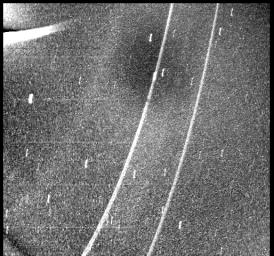
|
Neptune - Closest Approach
- Click the image above for a larger view
- Full-Res JPEG (512 x 480) (91.9 kB)
- Full-Res TIFF (512 x 480) (98.6 kB)
Caption:
The Voyager spacecraft took this picture after closest approach to Neptune on Aug. 25 1989, using the clear filter of the wide-angle camera with an exposure time of 255 seconds. The view back towards Neptune at a phase angle of 135 degrees found the two known rings to be five to 10 times brighter than seen in backscattering during Voyager approach at much lower phase angle. This brightness increase implies a large percentage of microscopic particles within the rings. Although the dominant arc-like clump of the outer ring is not seen here, the inner ring appears brighter than the outer ring at the longitudes seen in this image. A faint sheet of material is also revealed that extends from the faint ring at a radius of 53,200 kilometers(33,000 miles). A new and even fainter ring was discovered in this image at about 41,000 kilometers (25,400 miles), seen running from the lower left corner to about one-third the way across the top of the frame. This ring is quite broad, about 2,500 kilometers (1,550 miles) in radial width. In contrast to the two previously discovered rings, this feature is quite diffuse and has no well defined radial boundaries. The Voyager imaging experiment has now detected ring material in all of the radial regions in which it has been detected by groundbased stellar occultation experiments. The Voyager spacecraft was 720,000 kilometers (446,400 miles) from Neptune at the time of this exposure.
Background Info:
The Voyager Mission is conducted by JPL for NASA's Office of Space Science and Applications.
Cataloging Keywords:
| Name | Value | Additional Values |
|---|---|---|
| Target | Neptune | |
| System | ||
| Target Type | Planet | |
| Mission | Voyager | |
| Instrument Host | Cassini Orbiter | Voyager 2 |
| Host Type | Orbiter | Flyby Spacecraft |
| Instrument | Imaging Science Subsystem (ISS) | |
| Detector | Wide Angle Camera | |
| Extra Keywords | Grayscale, Occultation, Visual | |
| Acquisition Date | ||
| Release Date | 1999-07-25 | |
| Date in Caption | ||
| Image Credit | NASA/JPL | |
| Source | photojournal.jpl.nasa.gov/catalog/PIA01996 | |
| Identifier | PIA01996 | |
